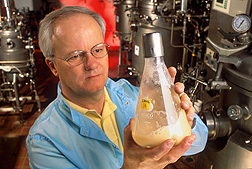Trump budget cuts would shut down Peoria ag lab
By Holly Eitenmiller For Chronicle Media — June 12, 2017
Now known as the National Center for Agricultural Utilization Research (NCAUR), through the years the lab has been expanded and renovated. The center focuses today is on bioenergy, new uses for renewable resources, and safe, healthy foods. NCAUR was designated as an International Historic Chemical Landmark in 2001. (Photo courtesy of USDA ARS)
Seventy-five years ago, chemists and engineers at the Northern Regional Research Lab in Peoria discovered a means to mass produce penicillin and, by June 1944, just in time for the Normandy Landings, nearly 300 billion units of the “wonder drug” were available.
Known now as the National Center for Agricultural Utilization Research, NCAUR, the building is among the American Chemical Society’s National Historic Chemical Landmarks. However, if President Donald Trump’s plan to cut 20.5 percent of USDA spending, the landmark will close.
Trump’s $4.1 trillion budget blueprint, released May 23, calls for the shuttering of 17 USDA sights, including the Peoria lab, which employs more than 200 people and is part of the Agricultural Research Service division of the USDA. (View federal budget proposal, https://www.obpa.usda.gov/18arsexnotes2018.pdf)
NCAUR is listed on the “Proposed Laboratory Closures” in the budget’s “Agricultural Research Service” section, and is tagged for “entire location closure.”
“(NCAUR) has a long history here in Peoria of doing terrific work,” Rep. Darin Lahood said May 31, following a visit to NCAUR. “Agriculture is the number one industry in the state of Illinois, and the work done at this facility helps not only our farmers, but farmers across the entire country,”
Indeed, since its start in 1940, chemists and engineers there have aggregated an impressive array of accomplishments, from the mass production of penicillin to curing devastating plant diseases to “Fantesk”, a NCAUR-patented cornstarch product key in the manufacture of low fat foods.

Microbiologist Mark Jackson and his colleagues at Peoria’s National Center for Agricultural Research have improved mass-production of beneficial fungi so they can be more effective and more economical biopesticides, an alternative to synthetic pesticides. (Photo courtesy of the USDA)
And, lest anyone forget, the super absorbent polymer, Super Slurper. In the 1970s, Peoria chemists created Super Slurper from corn starch. The polymer is capable of holding 2,000 times its weight in liquid and is found in artificial Hollywood snow, hot and cold therapy packs, surgical dressings, diapers and more.
However, Like Willy Wonka’s place in Roald Dahl’s, “Charlie and the Chocolate Factory,” the imposing building at 1815 N. University shows little hint of the curious happenings within.
On the rare occasion the building has opened to the public, much of the labyrinth of labs remain forbidden, accessible only to those with certain varying of security clearance. Of the inventions and discoveries there, however remarkable, very few garner much attention from the public.
Necessity often is the mother of invention with USDA research; the sort of inventions which may not always make headlines, but often result in impressive investment returns.
“Every dollar that’s invested into research at USDA, ARS returns a $17 impact on the economy. It’s the reciprocity of invention,” said USDA Director of Communications Christopher Bentley. “Penicillin resonates the most with people, but it’s the development of sucrose and other such things that have also made a serious impact.”
For now, Trump’s budget, Bentley said, is a first administrative foray with months to go before any sort of resolution occurs. However, if NCAUR remains on the budget, the facility could close before the end of the year.
Rep. Cheri Bustos called Trump’s budget “short-sighted” and said she considers NCAUR a “place of the future.” The building resides in Bustos’ 17th Congressional district, and the congresswoman has teamed with LaHood in a bipartisan effort to prevent the 17 proposed USDA facilities from closing.

Rep. Cheri Bustos, Dem. has teamed with republican Rep. Darin LaHood-R, In a bipartisan effort to spare the Center for Agricultural Utilization Research in Peoria. The lab is one of 17 agriculture facilities targeted on President Trump’s budget blueprint. Without federal funds, the landmark building will close. (Photo courtesy of Rep. Cheri Bustos)
In a June 2 letter to the House Appropriations Committee signed by LaHood, Bustos and 15 additional members of congress, the representatives wrote, “The vital research that is conducted at ARS facilities cannot be understated.”
“For example, (NCAUR) in Peoria, Illinois houses innovative research in novel industrial and other food products and agricultural commodities,” the letter states. “Historically, the work done at this facility has improved the lives of countless Americans, and includes the accomplishment of developing the mass production strategy for penicillin in the 1940s by Nobel Prize-winning scientists and was designated an International Historic Chemical Landmark in 2001.”
Trump’s budget, which also aims to slash $28.6 billion from federal crop insurance and reduce the Supplemental Nutrition Assistance Program (SNAP) by $193 billion, is considered a failure by groups in the agriculture sector.
A USA Rice Federation headline reads, “Trump budget declares war on agriculture” and according to Delta FarmPress, “Trump budget ‘fails agriculture and rural America.'”
— Trump budget cuts would shut down Peoria ag lab —



